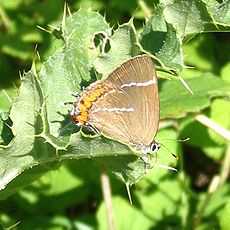White-letter Hairstreak
| White-letter Hairstreak | |
|---|---|
 | |
| Scientific classification | |
| Kingdom: | Animalia |
| Phylum: | Arthropoda |
| Class: | Insecta |
| Order: | Lepidoptera |
| Family: | Lycaenidae |
| Genus: | Satyrium |
| Species: | S. w-album |
| Binomial name | |
| Satyrium w-album (Knoch, 1782) | |
The White-letter Hairstreak (Satyrium w-album) is a butterfly in the family Lycaenidae.
Appearance, behaviour and distribution
A dark little butterfly that spends the majority of its life in the tree tops, feeding on honeydew, making it best observed through binoculars. The uppersides are a dark brown with a small orange spot in the bottom corner of the hindwing. The male has a small pale spot on the forewings made up of scent scales. The undersides are a lighter brown with a thin white line, the 'hairstreak' which gives this group of butterflies their name. On the hindwing this streak zigzags to form a letter 'W' (or 'M') from which this species gets its name. The outer edge of the hindwing has an orange border, but there is no orange on the forewings like the similar Black Hairstreak and there are two short tails on the hindwings. Part of a group known as "lateral baskers", they always rest with their wings closed.
Distribution
It is found throughout much of Europe, including Scandinavia, as far as the Urals, and occurs again in the Far East, including Japan. The insect has a widely disjunct distribution across the northern hemisphere. It is absent from North America.
United Kingdom
Widely but patchily distributed across most of England it is absent from Scotland, Ireland, western Wales and most of Cornwall. The spread of Dutch Elm Disease in the 1970s inevitably had a major impact on the British population but it has since recovered well in places and is still increasing its range.
In order to safeguard the future of this butterfly, some conservation organisations within the UK, such as the Hampshire and Isle of Wight branch of Butterfly Conservation and the Forestry Commission, have planted disease-resistant cultivars, notably 'Morfeo'. The beetle-resistant European White Elm Ulmus laevis has also been planted, notably by the Cheshire Wildlife Trust. More details about these projects can be found in the References section of this article.
Life cycle and foodplants
_2011-05-08.jpg)
Eggs are laid singly, usually on the girdle scars near the terminal buds of Elm trees. Wych elm Ulmus glabra is preferred, but English Elm Ulmus procera and Smooth-leaved Elm Ulmus minor var. minor are also used, as are some exotic species, notably Japanese Elm, and ornamental hybrid cultivars such as 'Sapporo Autumn Gold'. The butterfly normally breeds on mature trees, but there is some evidence to suggest that it may have adapted to the suckers arising from the roots of dead elms. Unlike other hairstreak eggs, White-letter Hairstreak eggs are harder to find during the winter months as they turn brown with age and thus far less distinct on the twigs.

The caterpillar hatches in March as the elm begins to flower. It feeds on the flowers and then seeds before moving onto the emergent leaves as the season progresses. Pupation takes place underneath a leaf or twig; there seems to be little association with ants. Adults are on the wing from late June until the middle of August in the UK, where there is one brood a year. The butterflies occasionally fly down from the canopies to nectar from flowers when honeydew is unavailable, notably after heavy rains have washed it from the leaves. The much-preferred flower is creeping thistle, but bramble and others are used. In France, the butterfly has been observed nectaring on Buddleja davidii.[1]
References
- Brookes, A.H. (2006). An evaluation of disease-resistant hybrid and exotic elms as larval host plants for the White-letter Hairstreak Satyrium w-album, Part 1 . Butterfly Conservation. Lulworth, UK.
- Davies, Martyn and Ceney, Bryan (1992) The White-letter Hairstreak Butterfly. Butterfly Conservation, Colchester, UK, 27p. ISBN 0-9512452-7-9
- The Vale Royal White-letter Hairstreak Project , Cheshire Wildlife Trust, UK.